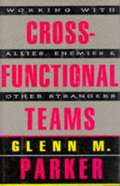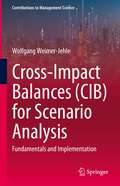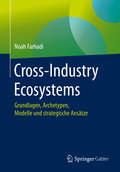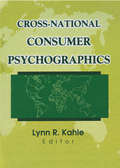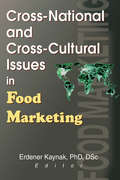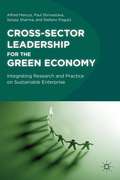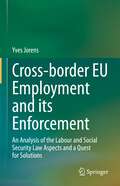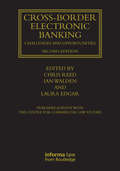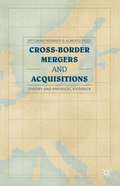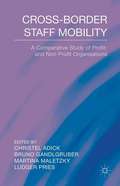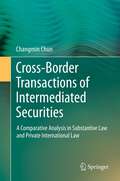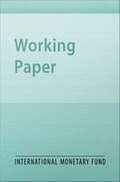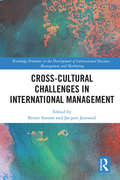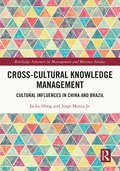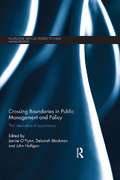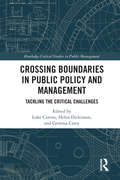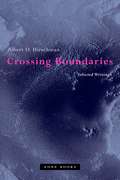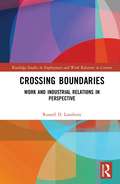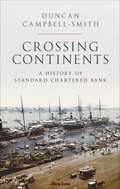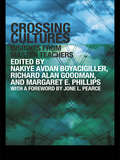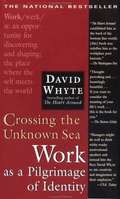- Table View
- List View
Cross-Functional Teams: Working with Allies, Enemies, and Other Strangers
by Glenn M. ParkerA practical guide to fluid and productive collaborations, with concrete advice to team members, team leaders, and senior management.
Cross-Impact Balances: Fundamentals and Implementation (Contributions to Management Science)
by Wolfgang Weimer-JehleCross-Impact Balances (CIB) is a method frequently used for research, in companies and in administrations for the systematic construction of qualitative scenarios. This book introduces the fundamentals of the method and uses a clear step-by-step example to explain how scenarios can be constructed with CIB. It describes possible problems in applying the method and offers help for various use cases. It includes a detailed discussion of the design decisions that shape a CIB application and the methods that can be used to collect the necessary data. The application examples presented provide a first impression of the possibilities of the method. A discussion of the strengths and limitations of the method offers guidance on the use cases in which CIB can be profitably applied. The book is valuable for researchers and practitioners in the field of scenario analysis.
Cross-Industry Ecosystems: Grundlagen, Archetypen, Modelle und strategische Ansätze
by Noah FarhadiIn diesem Buch stellt der Autor gewinnbringende strategische Maßnahmen für die Entwicklung und Implementierung branchenübergreifender Wachstumsstrategien vor. Dabei zählen Cross-Industry Joint Ventures, Unternehmensübernahmen, Fusionen und strategische Partnerschaften zu den wichtigsten Instrumenten. Den Ausführungen liegt das neuartige Konzept der betriebswirtschaftlichen Ökosysteme zugrunde. Noah Farhadi erläutert das Konzept sowie die unterschiedlichen Strategien unter anderem anhand der Automobil-, der Healthcare- sowie der Software-Branche. Eine Vielzahl von Beispielen aus der Praxis - u.a. Siemens, General Motors und SAP - beleuchtet die Komplexität von Cross-Sector Growth und Competition. Das Buch richtet sich gleichermaßen an Unternehmer, Manager und Berater wie an Lehrende und Studierende.
Cross-National Consumer Psychographics
by Lynn R Kahle Erdener KaynakWhat makes consumers behave as they do?Just as demographics examine the “who” of consumer behavior, psychographics examine the “why”. Psychographics show the motivations that people have in regard to purchasing products and choosing a lifestyle. The measurement approaches of psychographics utilize a combination of the personality, social value, and demographic variables. Cross-National Consumer Psychographics demonstrates that as communication and interactions between different parts of the world increase, marketing practitioners and educators will benefit by continuing to employ psychographic segmentation as a fundamental teaching and marketing tool. Examining consumer behavior with Cross-National Consumer Psychographics will bring you an improved understanding of the political and economic ties between communities and citizens, and will facilitate improved market understanding, segmentation, and communication.Cross-National Consumer Psychographics explores important marketing topics like: the role of psychographics and values in international marketing cross-cultural consumer information processing styles the relationship between independent and interdependent self-concepts and reasons for purchase the internationally recognized List of Values (LOV)and specific case studies including: the values of American and Japanese mothers (using the LOV) means-end analyses of fish consumption in Denmark and France effects of the change of sovereignty on consumer preferences in Hong KongCross-National Consumer Psychographics provides data from several applications of the List of Values (LOV) coming from various parts of the globe, showing the implications of particular cultures upon consumerism. Through this unique book, you will discover how countries and consumer groups can be segmented and approached based on their social values to help you develop more effective marketing strategies for your products.
Cross-National and Cross-Cultural Issues in Food Marketing
by Erdener KaynakEnhance your food marketing operation with this thorough and business-savvy book!Marketing and distribution related decisions and policies are now of paramount importance in the world of food marketing. This is due to the present state of economic crisis in much of the world and the cost efficiency issues that must be considered in countries at varying levels of economic development. Cross-National and Cross-Cultural Issues in Food Marketing examines food marketing systems from around the world to bring you an understanding of the opportunities and pitfalls in these areas. Cross-National and Cross-Cultural Issues in Food Marketing evaluates the present state and likely developments of food marketing systems in different countries. This book also provides conceptual frameworks for studying food marketing systems across countries and/or cultures. When studying food marketing systems from varying cultures, one must take into consideration the political, cultural, and environmental aspects of the countries involved. Cross-National and Cross-Cultural Issues in Food Marketing provides the information you need. In this book you can examine: the U.S. poultry export trade food market segmentation in Europe the yogurt market in the European Union (EU) the connection between agricultural exports and economic growth in Pakistan ethnic niche markets for import quality policies and consumer behavior in different countries . . . and more!Cross-National and Cross-Cultural Issues in Food Marketing has the information you'll need to be able to analyze, design,and manage effective food marketing systems in an increasingly global economy.
Cross-Sector Leadership for the Green Economy
by Paul Shrivastava Sanjay Sharma Alfred Marcus Stefano PogutzTechnology breakthroughs in sustainable renewable energy and energy conservation technologies require that there be a strong institutional ecosystem in place which supports innovation, but the nature of this foundation and how it works is not well-known. Becoming a leader necessitates new forms of cross-sector cooperation.
Cross-border EU Employment and its Enforcement: An Analysis of the Labour and Social Security Law Aspects and a Quest for Solutions
by Yves JorensThis book provides insights into the complex labour and social security framework of EU employment and its enforcement. Starting from an analysis of the various EU instruments and case law, it outlines the complicated legal framework, the practical problems involved, and ways to overcome them. In turn, the book puts the evolution of the framework into perspective, reviews the numerous modifications made over the years, and describes interpretation-related difficulties. Since the formation of the European Community 65 years ago, migration and the European labour market have evolved considerably through special patterns of (temporary) mobility such as postings, simultaneous work in several Member States and high mobility, thus leading to major questions about the applicable legal framework. The interplay between the free movement of persons and services has produced a complex system of rules. Which law applies when a person crosses a border: that of the host State (and to what extent should this State take into account the legal rules from the home State?) or that of the home State? Does the person crossing the border have any choice in the matter? The book subsequently analyses the penetration of EU (market) law into national systems of labour and social security law. The divergent solutions and views within labour and social security law are considered and discussed from a critical point of view. As the positive elements of the European story are at risk of being overshadowed by the negative consequences of the European construction – social dumping being the prime example – special attention is paid to the cooperation between inspection services and other stakeholders in order to guarantee efficient enforcement. The latter is more than just sanctioning, but also includes prevention and monitoring issues. The unique strength of this book is that it brings together all legal-technical aspects of cross-border employment and its enforcement in both labour law and social security law in a single volume. Readers will find a wealth of detailed and specialised information, helping them to understand the topic in depth. Accordingly, the book will be of interest to academics, practitioners, enforcement bodies, judiciary policymakers, advanced law students, and researchers seeking to understand the law in context.
Cross-border Electronic Banking: Challenges and Opportunities
by Laura Edgar Chris Reed Ian WaldenCross-border Electronic Banking addresses everything from the changes made to payment clearing since the deregulation of cross-border flows of funds, to the development of capital adequacy ratios and the Euro. This insightful and revealing book, backed up by extensive practical experience, will alert you to the ways that electronic banking practices affect even the simplest daily transactions, and will unveil the legal technicalities imposed by these developments.
Cross-border Mergers and Acquisitions
by Alberto Pezzi Ottorino MorresiCross-Border Mergers and Acquisitionsis the first book to offer a complete guide to understanding the main concepts, theories, and results driving cross-border MAs.
Cross-border Staff Mobility
by Ludger Pries Christel Adick Bruno Gandlgruber Martina MaletzkyCross-Border Staff Mobility addresses several research gaps in the study of organisations and rarely analysed areas such as the non-profit sector (NPOs). The book presents research on multinational corporations (MNCs) in emerging markets and integrates studies of MNCs and NPOs originating from Germany and Mexico (while most studies focus on US-American and English speaking organisations). This volume combines approaches from human resource management, business studies and organisation research, and incorporates micro- and macro-perspectives on organisations and institutions by using situational and neo-institutionalist frames.
Cross-border Transactions of Intermediated Securities: A Comparative Analysis in Substantive Law and Private International Law
by Changmin ChunThis work aims to analyse substantive and conflict of laws rules regarding intermediated securities in a comparative way. For this purpose, it examines major jurisdictions' rules for intermediated securities and the intermediated securities holding systems, such as the rules of the German, US, Korean, Japanese and Swiss systems, as well as the relevant EU regimes and initiatives. Above all, it analyses the two international instruments related to intermediated securities, i.e. the Geneva Securities Convention and the Hague Securities Convention. Through a functional comparative approach based upon legal traditions of the various jurisdictions, this book gives readers theoretical and practical information on intermediated securities and their national and international aspects.
Cross-country Consumption Risk Sharing, a Long-run Perspective
by Zhaogang QiaoA report from the International Monetary Fund.
Cross-cultural Challenges in International Management (Routledge Frontiers in the Development of International Business, Management and Marketing)
by Bruno Amann; Jacques JaussaudThe development of international business and of globalization in every field of activity requires the interaction of individuals and groups with diverse cultural, religious, ethnic and social characteristics in different institutional contexts. Cross-cultural Challenges in International Management addresses the various difficulties that may impede smooth communication and cooperation of those involved in such interactions. It examines what types of resources are mobilized to overcome such difficulties. The cultural and societal challenges of international management must be considered at different levels, the one of strategy, which the first part of the book is devoted to, but also that of management and business practices, addressed in the third part of the book. Both strategic decisions and daily business practices, however, in the particularly fluctuating and incompletely defined international context, gain from being framed by ethical and corporate social responsibility, which the second part of this book is devoted to. Cross-cultural Challenges in International Management provides an analysis of specific situations revealing such cultural or societal challenges. Thus, the reader will benefit not only from advanced theoretical knowledge in the field, but also from practical applications in various professional context and various countries. Practitioners, students in various fields of social sciences, particularly in management, communication, international relations, and researchers will widely benefit from this book.
Cross-cultural Knowledge Management: Cultural Influences in China and Brazil (Routledge Advances in Management and Business Studies)
by Jacky Hong Jorge Muniz Jr.Knowledge has become increasingly complex and important for organizations. Despite the growing recognition of the factors that enable knowledge management in organizations, our understanding about the unique cross-cultural challenges is rather limited. In particular, how cultural differences influence people’s participation in knowledge management activities still remains unclear. By conducting qualitative case studies and analytic hierarchical process (AHP) with multinational firms in Brazil and China, this book addresses the broader issue of cultural influences on knowledge management. Specific emphasis has been put on their indigenous cultural norms, including guanxi, face and jeitinho and the impacts they have on knowledge sharing. Drawing on an integrative knowledge management model, the results from AHP analysis reveal how some cultural-specific factors related to people, process and knowledge can affect the effectiveness of socialization, externalization and internalization processes in a production context. The book will be useful to both management academics and business practitioners. While academics will gain insight into the intricacies of knowledge sharing activities in production organizations, managers will find some useful conceptual tools to resolve the challenges of knowledge management in a cross-cultural context.
CrossBoundary Energy
by John D. MacomberAlmost 500 million people are without electricity in sub-Saharan Africa. Governments and public utilities are challenged to bring generation and distribution to most of them. Considerable promise exists in "off-grid" or "mini-grid" technologies, notably using renewable energy from wind and photovoltaics in areas that have plentiful supplies of both yet limited access to traditional fuels due to other infrastructure constraints. Cross-Boundary is an experienced consulting firm and transaction facilitator run by several Harvard and Stanford MBAs, some with recent military experience. In the case, the company needs to analyze and select which of two nations in Africa to enter next (Tanzania or Ghana) based on many aspects of each nation, has to decide which kinds of customers to serve who will compensate it directly for electricity, and whether to partner with developers and contractors or build that capability in-house. Critically, the company has to evaluate as it matures whether it should be a) an aggregator of capital from multiple investing and lending sources, investing in a vendor agnostic manner into multiple energy developers and projects which it identifies from afar; or b), whether to be primarily a large scale multi-national competitive energy developer and project delivery company needing to attract capital from many sources, all of whom are selecting between several other developers and investment opportunities. What is their key value added and where can they build a defensible strategy? Which one best accomplishes the goal of matching up money and projects to help illuminate Africa?
Crossing Borders: MTC's Journey through Africa
by Tarun Khanna Ayesha K. KhanThis is the story of MTC, a Kuwaiti telecom company that has grown from a sleepy, state monopoly to become one of the fastest growing telecom companies in the world, with the largest regional footprint across the Middle East and Africa. The CEO of the company, Dr. Saad Al Barrak had been successful in executing an aggressive growth plan that found its crown jewel in the acquisition of Celtel, one of the largest telecom companies in Sub-Saharan Africa. However, this acquisition threw MTC into a dynamic new context and marked the beginning of a very different phase. If Dr. Saad was going to lead MTC into the topmost ranks of global telecom, his team would have to successfully grapple with all the growing pains of managing across borders, brand names and cultures. All against the backdrop of an unpredictable African market with huge growth potential and rapidly increasing competition.
Crossing Borders: MTC's Journey through Africa
by Tarun Khanna Ayesha K. KhanThis is the story of MTC, a Kuwaiti telecom company that has grown from a sleepy, state monopoly to become one of the fastest growing telecom companies in the world, with the largest regional footprint across the Middle East and Africa. The CEO of the company, Dr. Saad Al Barrak had been successful in executing an aggressive growth plan that found its crown jewel in the acquisition of Celtel, one of the largest telecom companies in Sub-Saharan Africa. However, this acquisition threw MTC into a dynamic new context and marked the beginning of a very different phase. If Dr. Saad was going to lead MTC into the topmost ranks of global telecom, his team would have to successfully grapple with all the growing pains of managing across borders, brand names and cultures. All against the backdrop of an unpredictable African market with huge growth potential and rapidly increasing competition.
Crossing Boundaries in Public Management and Policy: The International Experience (Routledge Critical Studies in Public Management)
by John Halligan Janine O'Flynn Deborah BlackmanIn the 21st century governments are increasingly focusing on designing ways and means of connecting across boundaries to achieve goals. Whether issues are complex and challenging – climate change, international terrorism, intergenerational poverty– or more straightforward - provision of a single point of entry to government or delivering integrated public services - practitioners and scholars increasingly advocate the use of approaches which require connections across various boundaries, be they organizational, jurisdictional or sectorial. Governments around the world continue to experiment with various approaches but still confront barriers, leading to a general view that there is considerable promise in cross boundary working, but that this is often unfulfilled. This book explores a variety of topics in order to create a rich survey of the international experience of cross-boundary working. The book asks fundamental questions such as: What do we mean by the notion of crossing boundaries? Why has this emerged? What does cross boundary working involve? What are the critical enablers and barriers? By scrutinizing these questions, the contributing authors examine: the promise; the barriers; the enablers; the enduring tensions; and the potential solutions to cross-boundary working. As such, this will be an essential read for all those involved with public administration, management and policy.
Crossing Boundaries in Public Policy and Management: Tackling the Critical Challenges (Routledge Critical Studies in Public Management)
by Helen Dickinson Gemma Carey Luke CravenThis book aims to develop four key challenges that remain unresolved in the boundary-spanning literature, which span from the conceptual, to the practice, to the translational. In doing so, it tackles the question of boundary-spanning from four different angles, providing an in-depth investigation of the current state of the field in each of these realms, in addition to new directions for solving the identified challenges. Finally, the book synthesises the lessons from each of these challenges into a coherent and integrated final piece of the boundary dilemma. In doing so, it will provide depth and a clearer agenda for future research and practice. Crossing Boundaries in Public Policy and Management digs into the heart of enduring questions and challenges for cross-boundary working, providing in-depth conceptual contributions on the fundamental challenges of boundary work. It displays the latest state of knowledge on the topic and will be of interest to researchers, academics, practitioners, and students in the fields of public management, public policy, public administration, public-private relationships and coordination and collaboration.
Crossing Boundaries: Selected Writings
by Albert O. HirschmanDuring the last half century, Albert O. Hirschman has redefined the scope and limits of political economy. His contributions, as both a scholar and an economic advisor, have definitively shaped an innovative program for social change and economic development.Crossing Boundaries, a collection of Hirschman’s most recent writings, forges new and unforeseen connections between the past and the present, between intellectual life and lived experience. With astonishing frankness and humor, Hirschman recounts some of the most compelling and formative moments of his life that have influenced his thinking about economic and social development, democracy and capitalism. He also reconsiders the key terms of his scholarship — concepts he is constantly rethinking, subverting, and reinventing.
Crossing Boundaries: Work and Industrial Relations in Perspective (Routledge Studies in Employment and Work Relations in Context)
by Russell D. LansburyThis book provides thoughtful insights into the development in work, organisations and employment relations in the last 50 years. In a semi-autobiographical approach, the author reflects on important contributions by other scholars, practitioners, and policy makers to work and employment relations. The book covers a variety of themes which have been the subject of research undertaken by the author over his career and explores these themes over a period of time with examples drawn from various countries. It also emphasises that countries and regions cannot be understood in isolation from each other. The author seeks to convey the importance of crossing disciplinary boundaries in the social sciences in order to interpret changes in work, organisations and employment relations. Drawing on the author’s rich experience and research, the book is engaging and accessible to anyone who wishes to learn more about the rapidly changing workplace and employment relations.
Crossing Continents: A History of Standard Chartered Bank
by Duncan Campbell-SmithFor almost a hundred years from the 1860s, the City of London's overseas banks financed the global trade that lay at the core of the British Empire. Foremost among them from the beginning were two start-up ventures: the Standard Bank of South Africa, which soon developed a powerful domestic franchise at the Cape, and the Chartered Bank of India, Australia and China. This book traces their stories in the nineteenth century, their glory days before 1914 - and their remarkable survival in the face of global wars and the collapse of world trade in the first half of the twentieth century.The unravelling of the Empire after 1945 eventually forced Britain's overseas banks to confront a different future. The Standard and the Chartered, alarmed at the expansion of American banking, determined in 1969 on a merger as a way of sustaining the best of the City's overseas traditions. But from the start, Standard Chartered had to grapple with the fading fortunes of its own inherited franchise - badly dented in both Asia and Africa - and with radical changes in the nature of banking. Its British managers, steeped in the past, proved ill-suited to the challenge. By the late 1980s, efforts to expand in Europe and the USA had brought the merged Group to the brink of collapse.Yet it survived - and then pulled off a dramatic recovery. Standard Chartered realigned itself, just in time, with the phenomenal growth of Asia's 'emerging markets', many of them in countries where the Chartered had flourished a century earlier. In the process, the Group was transformed. Trebling its workforce, it brushed aside the global financial crisis of 2008 and by 2012 could look back on a decade of astonishing growth. Recent times have added an eventful postscript to a long and absorbing history.Crossing Continents recounts Standard Chartered's story with a wealth of detail from one of the richest archives available to any commercial bank. The book also affords a rare and compelling perspective on the evolution of international trade and finance, showing how Britain's commercial influence has actually worked in practice around the world over one hundred and fifty years.
Crossing Cultures: Insights from Master Teachers
by Nakiye Avdan Boyacigiller Richard Alan Goodman Margaret E. PhillipsCrossing Cultures provides a bold and refreshing new resource for teachers and trainers with proven methods for developing coping strategies and problem-solving skills in the cross-cultural arena. A comprehensive study structured to provide a framework for teaching; each chapter contains a teaching module, highlighting the potential difficulties, dialogues and variations in cross-cultural teaching. Ideal for those teaching Business across borders, this is a uniquely practical guide that features contributions from the leading lights of the field.
Crossing The Unknown Sea: Work As A Pilgrimage Of Identity
by David WhyteCrossing the Unknown Sea is about reuniting the imagination with our day to day lives. It shows how poetry and practicality, far from being mutually exclusive, reinforce each other to give every aspect of our lives meaning and direction. For anyone who wants to deepen their connection to their life's work—or find out what their life's work is—this book can help navigate the way. Whyte encourages readers to take risks at work that will enhance their personal growth, and shows how burnout can actually be beneficial and used to renew professional interest. He asserts that too many people blindly trudge through a mediocre work life because so many “busy” tasks prevent significant reflection and analysis of job satisfaction. People often turn to spiritual practice or religion to nurture their souls, but overlook how work can actually be our greatest opportunity for discovery and growth. Crossing the Unknown Sea combines poetry, gifted storytelling and Whyte's personal experience to reveal work's potential to fulfill us and bring us closer to ultimate freedom and happiness.
